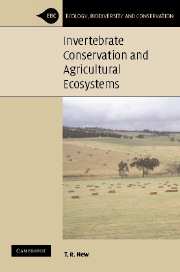Book contents
- Frontmatter
- Contents
- Preface
- Acknowledgements
- 1 Introduction: agricultural ecosystems and conservation
- 2 Agriculture and biodiversity: the place of invertebrates
- 3 Agriculture: effects on invertebrate diversity and conservation
- 4 Agricultural disturbance: diversity and effects on invertebrates
- 5 Biological control and invertebrate conservation
- 6 Cultural aspects of pest management
- 7 Extending beyond cropping areas
- 8 Field margins and landscape ecology
- 9 Pasture management and conservation
- 10 Towards more holistic management for invertebrates
- References
- Index
2 - Agriculture and biodiversity: the place of invertebrates
Published online by Cambridge University Press: 29 July 2009
- Frontmatter
- Contents
- Preface
- Acknowledgements
- 1 Introduction: agricultural ecosystems and conservation
- 2 Agriculture and biodiversity: the place of invertebrates
- 3 Agriculture: effects on invertebrate diversity and conservation
- 4 Agricultural disturbance: diversity and effects on invertebrates
- 5 Biological control and invertebrate conservation
- 6 Cultural aspects of pest management
- 7 Extending beyond cropping areas
- 8 Field margins and landscape ecology
- 9 Pasture management and conservation
- 10 Towards more holistic management for invertebrates
- References
- Index
Summary
The vast taxonomic and functional diversity of terrestrial invertebrates gives them massive importance in sustaining ecosystem functions, so that their conservation has substantial practical importance. This chapter introduces the importance of invertebrate biodiversity in agroecosystems, particularly arable systems, and how this importance may be appraised. The taxonomic variety of invertebrates is summarised, and brief comments on some major taxonomic groups illustrate their functions and roles as a basic rationale for conservation need.
Introduction
Agriculture is recognised widely as one of the largest contributors to worldwide loss of biodiversity. As McLaughlin & Mineau (1995) noted, ‘if we are serious about our commitment to conserve biodiversity, we will need to fully consider the effects of common agricultural practices, such as tillage, drainage, intercropping, rotation, grazing, pesticide and fertiliser use on wild flora and fauna’. Robinson & Sutherland (2002) noted that whilst agricultural intensification has had a wide range of impacts on biodiversity, data on many species are insufficient to enable any detailed assessment to be made of the factors involved. Writing particularly of Britain, they commented that initially (in the 1950s and 1960s), reduction of habitat diversity was the important factor, whilst more recently, reduction in habitat quality is probably more important. Not surprisingly, declines have been most marked in habitat specialists, so that many of the species at present common on farmland are relative generalists, able to withstand considerable disturbance.
- Type
- Chapter
- Information
- Invertebrate Conservation and Agricultural Ecosystems , pp. 18 - 52Publisher: Cambridge University PressPrint publication year: 2005



